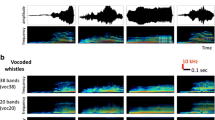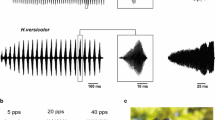Summary
-
1.
The tonotopically organized auditory neostriatum (Field L1,L2,L3) was examined in 7 animals for single units which respond to Iambus-like calls and other calls (responsive units), or which clearly distinguish Iambus-like calls of the guinea fowl from other calls of the species (selective units). A high proportion of responsive (168 units: 46%) and of selective units (58 units: 16%) was localized in an area with best frequencies of units between 1 and 2 kHz. Only selective units are described in this paper.
-
2.
Stimulation with 16 natural variations of the Iambus call showed that the 58 selective units formed a population of comparable neurons, in that 80% responded to more than 9 Iambus variations. High response coincidences of neurons to particular Iambus variations indicated that the neuronal preference relied on characteristic lines in the Iambus spectrum and not on accidental properties (Figs. 1–6).
-
3.
In most Iambi the energy is concentrated in spectral lines between 1 and 2.3 kHz. This band is called the doininant spectral band. The highest response score for Iambus variations contained those units which responded to tones of 1.8 and 1 kHz within the dominant band (Figs. 8, 11). One kHz is the fundamental frequency of the harmonic Iambus spectrum, and 1.8 kHz comes close to the formant, i.e. the energy maximum of an average Iambus spectrum. Selective units rarely responded to 1.5 kHz, and Iambus variations with a strong 1.5 kHz component least frequently elicited responses from units (Figs. 8, 11).
-
4.
Half of the selective units showed multiple response maxima when stimulated with tone bursts. One or several maxima were between 1 and 2 kHz. Most other units showed suppression of activity between 1 and 2 kHz or no tone responses (Figs. 9–11). The absence of a tone response was no indication of a higher call selectivity of units.
-
5.
Pulse trains of different periodicity (P) generate harmonic spectra with varying fundamental frequencies (Figs. 13, 14). These stimuli frequently yielded neuronal response maxima at 1 kHz fundamental frequency (the fundamental of Iambus-like calls) as well as maxima at 1.8 kHz and below 700 Hz. Such maxima were also observed in units with no pure tone response or with no tone response in this band (Figs. 9–11).
-
6.
Pulse trains which are amplitude modulated (PAM) generate harmonic spectra with sidebands (Fig. 12). A majority of selective units gave prominent responses to PAM with a combination of 900 Hz to 1.2 kHz fundamental frequency and sidebands of 50 Hz to several hundred Hz distance from the harmonics (Figs. 9, 10). This corresponds to the characteristic spectral lines of Iambus calls (Figs. 13, 14).
-
7.
In other units the spectral envelope of PAM stimuli had to be adjusted to the formant of Iambi by bandpass filtering the signal in order to obtain prominent responses (Fig. 11). These stimuli (Figs. 13, 14) mimic focal properties, i.e. the complete spectral construction of Iambi.
-
8.
One of the most important findings appears to be that selective units were far more specialized to distinguish Iambi from other wide-band calls with spectral overlap in the dominant spectral band than they were to distinguish Iambi from their simple or complex spectral components.
Similar content being viewed by others
Abbreviations
- AN :
-
auditory neostriatum
- IR :
-
isointensity response
- P :
-
pulse train stimulation
- PAM :
-
pulse amplitude modulation
References
Abeles, M., Goldstein, M.H.: Responses of single units in the primary auditory cortex of the cat to tones and tone pairs. Brain Res.42, 337–352 (1972)
Biederman-Thorson, M.: Auditory responses of neurons in the lateral mesencephalic nucleus (inferior colliculus) of the Barbary Dove, J. Physiol. London193, 695–705 (1967)
Biederman-Thorson, M.: Auditory responses of units in the ovoid nucleus and cerebrum (Field L) of the ring dove. Brain Res.24, 247–265 (1970)
Bogdanski, D.F., Galambos, R.: Studies of the auditory system with implanted electrodes. In: Neural mechanisms of auditory and vestibular system. Rasmussen, G.L., Windle, W.F., (eds.), pp. 143–148. Springfield, Ill.: Thomas 1960
Burdick, C.K., Miller, J.D.: Speech perception by the chinchilla: Discrimination of sustained /a/ and /i/. J. Acoust. Soc. Am.58, 415–427 (1975)
Capranica, R.R.: In: Auditory processing of biologically significant sounds. Worden, F.G., Galambos, R. (eds.). Neurosci. Res. Program Bull.10, (1972)
Delattre, P., Liberman, A., Cooper, F.: An experimental study of the acoustic determination on one and two formant vowels synthesized from spectrographic pattern. Word8, 195–210 (1952)
Evans, D.F.: Neural responses for the detection of acoustic patterns and for sound localization. In: The neurosciences, Third Study Program. Schmitt, F.O., Quarton, G.C. (eds.). pp. 131–145. Cambridge: MIT Press 1974
Fant, C.G.M.: Acoustic theory of speech production. 's Gravenhagen: Mounton 1960
Frishkopf, L.S., Capranica, R.R., Goldstein, M.H., Jr.: Neural coding in the bullfrogs auditory system — a teleological approach. Proc. IEEE56, 969–980 (1968)
Gersuni, G.V., Vartanian, J.A.: Time dependent features of adequate sound stimuli and the functional organization of central auditory neurons. In: Basic mechanisms in hearing. Møller, A.R. (ed.), pp. 623–673. New York, London: Academic Press 1973
Goldstein, M.H., Jr., Hall, J.L., Butterfield, B.O.: Single unit activity in primary auditory cortex of unanesthetized cats. J. Acoust. Soc. Am.43, 444–455 (1968)
Goldstein, M.H., Jr., Abeles, M.: Single unit activity of the auditory cortex. In: Handbook of sensory physiology, Vol. V/2. Keidel, W.D., Neff, W.D. (eds.), pp. 199–218, Berlin, Heidelberg, New York: Springer 1975
Greenewalt, C.H.: Bird song: Acoustics and physiology. City of Washington: Smithsonian Institution Press 1968
Hubel, D.H., Wiesel, T.N.: Receptive fields, binocular interaction and functional architecture in the cat's visual cortex. J. Physiol. London160, 106–154 (1962)
Huber, F.: In: Auditory processing of biologically significant sounds. Neurosci. Res. Program Bull.10, (1972)
Klatt, D.H., Stefanski, R.A.: How does a mynah bird imitate human speech? J. Acoust. Soc. Am.55, 822–832 (1974)
Leppelsack, H.J.: Funktionelle Eigenschaften der Hörbahn im Feld L des Neostriatum caudale des Staren (Sturnus vulgaris L., Aves). J. Comp. Physiol.88, 271–320 (1974)
Leppelsack, H.J., Vogt, M.: Responses of auditory neurons in the forebrain of a songbird to stimulation with species-specific sounds. J. Comp. Physiol.107, 263–274 (1976)
Maier, V.: Vocal communication in Guinea fowl (Numida meleagris). Proc. of the XV International Ethological Conference, Bielefeld, Section II, p. 48 (1977)
Marler, P.R.: The structure of animal communication sounds. In: Dahlem Workshop on: Recognition of complex acoustic signals. Bullock, T.H. (ed.), pp. 17–35, Berlin 1977
Møller, A.R.: Unit responses in the rat cochlear nucleus to tones of rapidly varying frequency and amplitude. Acta Physiol. Scand.81, 540–556 (1971)
Mudry, K.M., Constantine-Paton, M., Capranica, R.R.: Auditory sensitivity of the diencephalon of the leopard frogRana p. pipiens. J. Comp. Physiol.114, 1–13 (1977)
Newman, J.D., Bodenstein, G., Bullock, T.H., Capranica, R.R., Ehret, G., Evans, E.F., Goldstein, J.L., Hellweg, F.C., Huber, F., Kalmring, K., Langner, G., Leppelsack, H.J., Mueller-Preuss, P., Neff, W.D., Scheich, H., Sovijärvi. A.R.A., Suga, N., Worden, F.G.: Biological filtering and neural mechanisms. Group report. In: Dahlem Workshop on: Recognition of complex acoustic signals. Bullock, T.H., (ed.), pp. 279–306, Berlin 1977
Newman, J.D., Wollberg, Z.: Multiple coding of species-specific vocalizations in the auditory cortex of squirrel monkeys. Brain Res.54, 287–304 (1973)
Oonishi, S., Katsuki, Y.: Functional organization and integrative mechanism in the auditory cortex of the cat. Jap. J. Physiol.15, 342–365 (1965)
Potter, R., Steinberg, J.: Towards the specification of speech. J. Acoust. Soc. Am.22, 807–820 (1950)
Sachs, M.B., Sinott, J.M., Woolf, N.K. Response properties of avian auditory nerve fibers and medullary neurons, Abstracts XVII. Int. Congr. Ornithol. Berlin, p. 45 (1978)
Scheich, H.: Central processing of complex sounds and feature analysis. In: Dahlem Workshop on: Reccgnition of complex acoustic signals. Bullock, T.H., (ed.), pp. 161–182, Berlin 1977
Scheich, H., Langner, G., Koch, R.: Coding of narrow-band and wide-band vocalizations in the auditory midbrain nucleus (MLD) of the Guinea fowl (Numida meleagris). J. Comp. Physiol.117, 245–265 (1977)
Sebeok, A.: How animals communicate. Bloomington, London: Indiana University Press 1978
Stopp, P.E., Whitfield, J.C.: Unit responses from brain-stem nuclei in the pigeon. J. Physiol. London158, 165–177 (1961)
Suga, N.: Feature extraction in the auditory system of bats. In: Basic mechanisms in hearing. Møller, A.R. (ed.), pp. 675–744. New York, London: Academic Press 1973
Suga, N.: Amplitude spectrum representation in the Doppler-shifted CF processing area of the auditory cortex of the mustache bat. Science196, 64–67 (1977)
Suga, N., Jen, P.H.-S.: Disproportionate tonotopic representation for processing CF-FM sonar signals in the mustache bat auditory cortex. Science194, 542–544 (1976)
Winter, P.A., Funkenstein, H.H.: The effect of species-specific vocalizations on the discharge of auditory cortical cells in the awake squirrel monkey (Saimiri sciureus). Exp. Brain Res.18, 489–504 (1973)
Author information
Authors and Affiliations
Additional information
Supported by the Deutsche Forschungsgemeinschaft Me 365/4, Sche 132/4
Rights and permissions
About this article
Cite this article
Scheich, H., Langner, G. & Bonke, D. Responsiveness of units in the auditory neostriatum of the guinea fowl (Numida meleagris) to species-specific calls and synthetic stimuli. J. Comp. Physiol. 132, 257–276 (1979). https://doi.org/10.1007/BF00614497
Accepted:
Issue Date:
DOI: https://doi.org/10.1007/BF00614497




